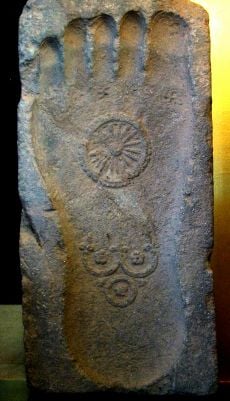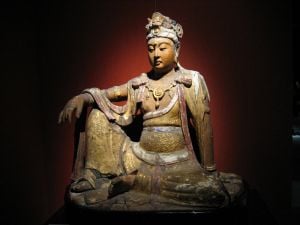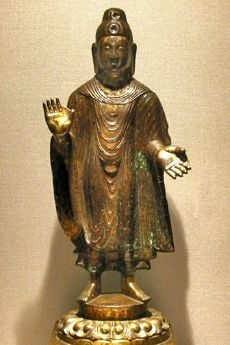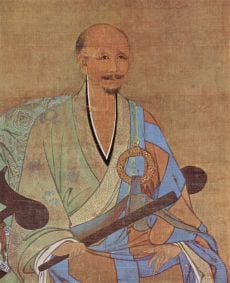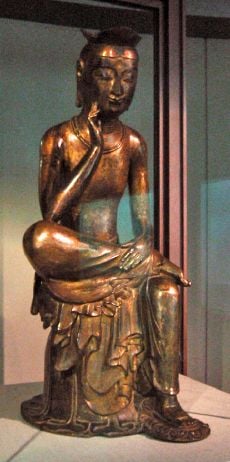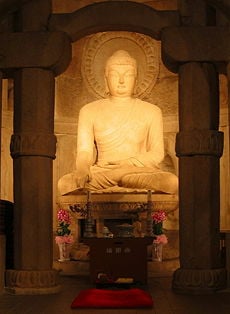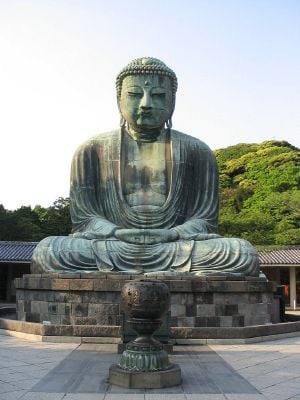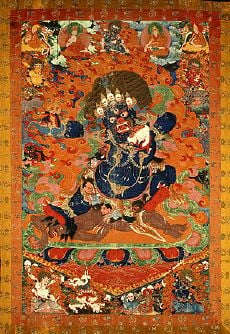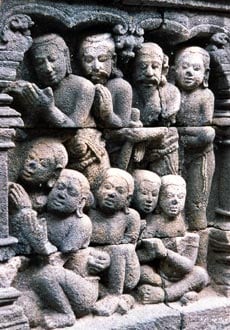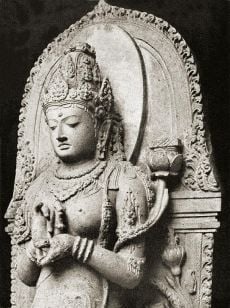Difference between revisions of "Buddhist Art" - New World Encyclopedia
Scott Dunbar (talk | contribs) m |
Rosie Tanabe (talk | contribs) |
||
| (16 intermediate revisions by 7 users not shown) | |||
| Line 1: | Line 1: | ||
| − | {{ | + | {{Approved}}{{Submitted}}{{Images OK}}{{Paid}}{{Copyedited}} |
| − | '''Buddhist art''' | + | [[Image:Mandala gross.jpg|thumb|right|200px|A Buddhist [[mandala]] from the Tibetan tradition.]] |
| + | '''Buddhist art''' refers to the rich and diverse representations of religious images, [[sculpture]], [[dance]], visual mythology, and [[Symbolism|symbols]] deriving from the various [[Buddhism|Buddhist]] communities found around the world. Buddhist art exhibits distinctive forms and characteristics reflecting the diverse cultures and countries in which it has spread. | ||
| − | Early Buddhist art, | + | Early Buddhist art emerged in [[India]] and [[Sri Lanka]] following the death of [[Gautama Buddha]] (563 B.C.E. to 483 B.C.E.). This original, formative period of Buddhist art was [[aniconic]] in character (avoiding direct representation of the human figure). However, around the first century C.E., following the Greek invasion of northwestern India and Buddhist contact with Hellenistic culture in the [[Indo-Greek Kingdom|Indo-Greek Kingdoms]], an [[iconic]] period of Buddhist art began to flourish in India. The growth of Buddhist art, in turn, influenced the development of [[Hinduism|Hindu]] art, until Buddhism virtually disappeared in India around the tenth century due, in part, to the vigorous expansion of both [[Islam]] and Hinduism. |
| − | + | {{toc}} | |
| − | Buddhist | + | From its original homeland of India, Buddhist art was transported to other parts of [[Asia]] and the world, adapting to local styles and norms in each new host country. Today, Buddhist art constitues an important part of overall Buddhist cultural legacy. |
| − | |||
| − | |||
==History in India== | ==History in India== | ||
| − | ===Aniconic phase ( | + | ===Aniconic phase (fifth century - first century B.C.E.)=== |
| − | [[Image:Buddha-Footprint.jpeg|thumb|upright|left|Footprint of the [[Buddha]]. | + | [[Image:Buddha-Footprint.jpeg|thumb|upright|left|Footprint of the [[Buddha]]. First century, [[Gandhara]].]] |
| − | Although India | + | Although India has a long sculptural tradition and a mastery of rich iconography, the Buddha was not represented in human form during the first few centuries of Buddhism. This reluctance towards [[anthropomorphic]] representations of the Buddha, and the sophisticated development of aniconic symbols to avoid it (even in narrative scene where other human figures would appear), seems to be connected 70 Buddha’s sayings, reported in the [[Dighanikaya]], that disfavored representations of himself after the extinction of his body. This tendency remained as late as the second century C.E. in the southern parts of India, in the art of the [[Amaravati]] school. While earlier anthropomorphic representations of the Buddha may have been made of wood and may have perished since then. However, no related archaeological evidence has been found. |
| − | |||
| − | + | What developed in the place of sculpted images of the Buddha was a rich period of aniconic art whereby the Buddha (and his teachings) were represented by diverse symbols. For example, some of these common symbols were the footprint (see picture inset), which represented, among other things, the Buddhist doctrine of ''[[anitya]]''(impermanence), an empty throne, and the wheel of dhamma. | |
| − | |||
| − | Anthropomorphic representations of the Buddha started to emerge from the | + | ===Iconic phase (1st century CE – present)=== |
| + | |||
| + | Anthropomorphic representations of the Buddha started to emerge from the first century C.E. in northern India. During the second to first century B.C.E., sculptures became more explicit, representing episodes of the Buddha’s life and teachings. These took the form of votive tablets or [[frieze]]s, usually in relation to the decoration of stupas. The two main centers of creation have been identified as [[Gandhara]] in today’s [[Punjab (Pakistan)|Punjab]], in [[Pakistan]], and the region of [[Mathura]], in central northern India. | ||
The art of Gandhara benefited from centuries of interaction with Greek culture since the conquests of [[Alexander the Great]] in 332 B.C.E. and the subsequent establishment of the [[Greco-Bactrian Kingdom|Greco-Bactrian]] and [[Indo-Greek Kingdom]]s, leading to the development of [[Greco-Buddhist art]]. Gandharan Buddhist sculpture displays [[Art in Ancient Greece|Greek artistic]] influence, and it has been suggested that the concept of the “man-god” was essentially inspired by [[Greek mythology|Greek mythological]] culture. Artistically, the Gandharan school of sculpture is said to have contributed wavy hair, drapery covering both shoulders, shoes and sandals, acanthus leaf decorations, etc. | The art of Gandhara benefited from centuries of interaction with Greek culture since the conquests of [[Alexander the Great]] in 332 B.C.E. and the subsequent establishment of the [[Greco-Bactrian Kingdom|Greco-Bactrian]] and [[Indo-Greek Kingdom]]s, leading to the development of [[Greco-Buddhist art]]. Gandharan Buddhist sculpture displays [[Art in Ancient Greece|Greek artistic]] influence, and it has been suggested that the concept of the “man-god” was essentially inspired by [[Greek mythology|Greek mythological]] culture. Artistically, the Gandharan school of sculpture is said to have contributed wavy hair, drapery covering both shoulders, shoes and sandals, acanthus leaf decorations, etc. | ||
| Line 26: | Line 25: | ||
Mathura and Gandhara also strongly influenced each other. During their artistic florescence, the two regions were even united politically under the [[Kushan Empire|Kushans]], both being capitals of the empire. It is still a matter of debate whether the anthropomorphic representations of Buddha was essentially a result of a local evolution of Buddhist art at Mathura, or a consequence of Greek cultural influence in Gandhara through the [[Greco-Buddhism|Greco-Buddhist]] [[syncretism]]. | Mathura and Gandhara also strongly influenced each other. During their artistic florescence, the two regions were even united politically under the [[Kushan Empire|Kushans]], both being capitals of the empire. It is still a matter of debate whether the anthropomorphic representations of Buddha was essentially a result of a local evolution of Buddhist art at Mathura, or a consequence of Greek cultural influence in Gandhara through the [[Greco-Buddhism|Greco-Buddhist]] [[syncretism]]. | ||
| − | |||
This iconic art was characterized from the start by a realistic idealism, combining realistic human features, proportions, attitudes and attributes, together with a sense of perfection and serenity reaching to the divine. This expression of the Buddha became the iconographic canon for subsequent Buddhist art. | This iconic art was characterized from the start by a realistic idealism, combining realistic human features, proportions, attitudes and attributes, together with a sense of perfection and serenity reaching to the divine. This expression of the Buddha became the iconographic canon for subsequent Buddhist art. | ||
| − | The pink [[sandstone]] sculptures of Mathura evolved during the [[Gupta Empire|Gupta]] period ( | + | The pink [[sandstone]] sculptures of Mathura evolved during the [[Gupta Empire|Gupta]] period (fourth to sixth century) to reach a very high fineness of execution and delicacy in their modeling. The art of the Gupta school was extremely influential almost everywhere in the rest of Asia. By the tenth century, Buddhist art creation was dying out in India, as [[Hinduism]] and [[Islam]] ultimately prevailed. |
==History Outside India== | ==History Outside India== | ||
===Northern Buddhist art=== | ===Northern Buddhist art=== | ||
[[Image:Wood Bodhisattva.jpg|left|thumb|A Chinese wooden [[Bodhisattva]] from the [[Song Dynasty]] (960-1279 C.E.)]] | [[Image:Wood Bodhisattva.jpg|left|thumb|A Chinese wooden [[Bodhisattva]] from the [[Song Dynasty]] (960-1279 C.E.)]] | ||
| − | As Buddhism expanded outside of India from the | + | As Buddhism expanded outside of India from the first century C.E., its original artistic package blended with other artistic influences, leading to a progressive differentiation among the countries adopting the faith. |
| − | * A '''Northern route''' was established from the | + | * A '''Northern route''' was established from the first century C.E. through [[Central Asia]], [[Tibet]], [[Bhutan]], [[China]], [[Korea]], and [[Japan]], in which [[Mahayana]] Buddhism prevailed. |
* A '''Southern route''', where [[Theravada]] Buddhism dominated, went through [[Myanmar]], [[Thailand]], [[Cambodia]], and [[Vietnam]]. | * A '''Southern route''', where [[Theravada]] Buddhism dominated, went through [[Myanmar]], [[Thailand]], [[Cambodia]], and [[Vietnam]]. | ||
| − | The [[Silk Road transmission of Buddhism]] to Central Asia, China and ultimately Korea and Japan started in the | + | The [[Silk Road transmission of Buddhism]] to Central Asia, China and ultimately Korea and Japan started in the first century C.E. with a semi-legendary account of an embassy sent to the West by the Chinese Emperor [[Emperor Ming of Han China|Ming]] (58-75 C.E.). However, extensive contacts started in the second century C.E., probably as a consequence of the expansion of the [[Kushan Empire]] into the Chinese territory of the [[Tarim Basin]], with the missionary efforts of a great number of Central Asian Buddhist monks to Chinese lands. The first missionaries and translators of Buddhists scriptures into [[Chinese language|Chinese]], such as [[Lokaksema]], were either [[Parthia]]n, [[Kushan]], [[Sogdian]] or [[Kuchean]]. |
| − | Central Asian missionary efforts along the [[Silk Road]] were accompanied by a flux of artistic influences, visible in the development of Serindian art from the | + | Central Asian missionary efforts along the [[Silk Road]] were accompanied by a flux of artistic influences, visible in the development of Serindian art from the second through the 11th century CE in the Tarim Basin, modern Xinjiang. Serindian art often derives from the [[Greco-Buddhist art]] of the [[Gandhara]] district of what is now [[Pakistan]], combining Indian, Greek and [[Roman art|Roman]] influences. Silk Road Greco-Buddhist artistic influences can be found as far as Japan to this day, in architectural motifs, Buddhist imagery, and a select few representations of [[Kami|Japanese gods]]. |
| − | The art of the northern route was also highly influenced by the development of [[Mahayana]] Buddhism, an inclusive faith characterized by the adoption of new texts, in addition to the traditional [[Pali canon]], and a shift in the understanding of Buddhism. Mahayana goes beyond the traditional [[Theravada]] ideal of the release from suffering | + | The art of the northern route was also highly influenced by the development of [[Mahayana]] Buddhism, an inclusive faith characterized by the adoption of new texts, in addition to the traditional [[Pali canon]], and a shift in the understanding of Buddhism. Mahayana goes beyond the traditional [[Theravada]] ideal of the release from suffering ''([[dukkha]])'' and personal enlightenment of the [[arhat]]s, to elevate the Buddha to a god-like status, and to create a pantheon of quasi-divine [[Bodhisattva]]s devoting themselves to personal excellence, ultimate knowledge and the salvation of humanity. Northern Buddhist art thus tends to be characterized by a very rich and syncretic Buddhist pantheon, with a multitude of images of the various [[Buddha]]s, Bodhisattvas and lesser deities. |
===Afghanistan=== | ===Afghanistan=== | ||
| − | + | Buddhist art in [[Afghanistan]] (old [[Bactria]]) flourished for several centuries until the spread of Islam in the seventh century. It was exemplified by the [[Buddhas of Bamyan]]. Other sculptures, in [[stucco]], [[schist]] or [[clay]], display very strong blending of Indian post-[[Gupta Empire|Gupta]] mannerism and Classical influence, [[Hellenistic civilization|Hellenistic]] or possibly even [[Greco-Roman]]. | |
| − | Buddhist art in [[Afghanistan]] (old [[Bactria]]) flourished for several centuries until the spread of Islam in the | ||
Although Islamic rule was rather tolerant of other religions “[[People of the Book|of the Book]],” it showed little tolerance for Buddhism, which was perceived as a religion depending on [[idolatry]]. Human figurative art forms also being prohibited under Islam, Buddhist art suffered numerous attacks, which culminated with the systematic destructions by the [[Taliban]] regime. The Buddhas of Bamyan, the sculptures of [[Hadda]], and many of the remaining artifacts at the Afghanistan museum have been destroyed. | Although Islamic rule was rather tolerant of other religions “[[People of the Book|of the Book]],” it showed little tolerance for Buddhism, which was perceived as a religion depending on [[idolatry]]. Human figurative art forms also being prohibited under Islam, Buddhist art suffered numerous attacks, which culminated with the systematic destructions by the [[Taliban]] regime. The Buddhas of Bamyan, the sculptures of [[Hadda]], and many of the remaining artifacts at the Afghanistan museum have been destroyed. | ||
| Line 53: | Line 50: | ||
===Central Asia=== | ===Central Asia=== | ||
| − | [[Central Asia]] long played the role of a meeting place between China, India and [[Iran|Persia]]. During the | + | [[Central Asia]] long played the role of a meeting place between China, India and [[Iran|Persia]]. During the second century B.C.E., the expansion of the [[Han Dynasty|Former Han]] to the West led to increased contact with the Hellenistic civilizations of Asia, especially the [[Greco-Bactrian Kingdom]]. |
| − | |||
Thereafter, the expansion of Buddhism to the North led to the formation of Buddhist communities and even Buddhist kingdoms in the oases of Central Asia. Some [[Silk Road]] cities consisted almost entirely of Buddhist stupas and monasteries, and it seems that one of their main objectives was to welcome and service travelers between East and West. | Thereafter, the expansion of Buddhism to the North led to the formation of Buddhist communities and even Buddhist kingdoms in the oases of Central Asia. Some [[Silk Road]] cities consisted almost entirely of Buddhist stupas and monasteries, and it seems that one of their main objectives was to welcome and service travelers between East and West. | ||
| − | The eastern part of Central Asia ([[Chinese Turkestan]] ([[Tarim Basin]], [[Xinjiang]]) in particular has revealed an extremely rich | + | The eastern part of Central Asia ([[Chinese Turkestan]] ([[Tarim Basin]], [[Xinjiang]]) in particular has revealed an extremely rich Serindian art (wall [[paintings]] and reliefs in numerous caves, portable paintings on canvas, sculpture, ritual objects), displaying multiple influences from Indian and Hellenistic cultures. Works of art reminiscent of the Gandharan style, as well as scriptures in the Gandhari script Kharoshti have been found. These influences were rapidly absorbed however by the vigorous Chinese culture, and a strongly Chinese particularism develops from that point. |
===China=== | ===China=== | ||
| − | |||
Buddhism arrived in [[China]] around the 1st century CE, and introduced new types of art into China, particularly in the area of [[statue|statuary]]. Receiving this distant religion, strong Chinese traits were incorporated into Buddhist art. | Buddhism arrived in [[China]] around the 1st century CE, and introduced new types of art into China, particularly in the area of [[statue|statuary]]. Receiving this distant religion, strong Chinese traits were incorporated into Buddhist art. | ||
| Line 71: | Line 66: | ||
====Tang Dynasty==== | ====Tang Dynasty==== | ||
| − | Following a transition under the [[Sui|Sui Dynasty]], Buddhist sculpture of the [[Tang Dynasty|Tang]] evolved towards a markedly life-like expression. Because of the dynasty’s openness to foreign influences, and renewed exchanges with Indian culture due to the numerous travels of Chinese Buddhist monks to India, Tang dynasty Buddhist sculpture assumed a rather classical form, inspired by the Indian art of the Gupta period. During that time, the Tang capital of | + | Following a transition under the [[Sui|Sui Dynasty]], Buddhist sculpture of the [[Tang Dynasty|Tang]] evolved towards a markedly life-like expression. Because of the dynasty’s openness to foreign influences, and renewed exchanges with Indian culture due to the numerous travels of Chinese Buddhist monks to India, Tang dynasty Buddhist sculpture assumed a rather classical form, inspired by the Indian art of the Gupta period. During that time, the Tang capital of Chang'an (today's [[Xi'an]]) became an important center for Buddhism. From there, Buddhism spread to [[Korea]], and Japanese embassies of Kentoshi helped it gain a foothold in Japan. |
[[Image:TangBodhisattva.JPG|thumb|upright|Tang [[Bodhisattva]].]] | [[Image:TangBodhisattva.JPG|thumb|upright|Tang [[Bodhisattva]].]] | ||
| − | However, foreign influences came to be negatively perceived in China towards the end of the Tang dynasty. In the year 845, the Tang emperor [[Emperor Wuzong of Tang China|Wuzong]] outlawed all “foreign” religions (including Christian [[Nestorianism]], [[Zoroastrianism]] and [[Buddhism]]) in order to support the indigenous religion, [[ | + | However, foreign influences came to be negatively perceived in China towards the end of the Tang dynasty. In the year 845, the Tang emperor [[Emperor Wuzong of Tang China|Wuzong]] outlawed all “foreign” religions (including Christian [[Nestorianism]], [[Zoroastrianism]] and [[Buddhism]]) in order to support the indigenous religion, [[Daoism]]. He confiscated Buddhist possessions, and forced the faith to go underground, therefore affecting the development of the religion and its arts in China. |
| − | [[Chán]] Buddhism | + | [[Chán]] Buddhism (the origin of Japanese [[Zen]]), however, continued to prosper for some centuries, especially under the [[Song Dynasty]] (960-1279), when Chan monasteries were great centers of culture and learning. |
[[Image:Chinesischer Maler von 1238 001.jpg|thumb|left|upright|Portrait of the Chinese [[Zen]] Buddhist [[Wuzhun Shifan]], painted in 1238 C.E., [[Song Dynasty]].]] | [[Image:Chinesischer Maler von 1238 001.jpg|thumb|left|upright|Portrait of the Chinese [[Zen]] Buddhist [[Wuzhun Shifan]], painted in 1238 C.E., [[Song Dynasty]].]] | ||
| − | The popularization of Buddhism in China has made the country home to one of the richest collections of Buddhist arts in the world. The [[Mogao Caves]] near [[Dunhuang]] and the [[Bingling Temple]] caves near [[Yongjing]] in [[Gansu]] province, the [[Longmen Grottoes]] near [[Luoyang]] in [[Henan]] province, the [[Yungang Grottoes]] near [[Datong]] in [[Shanxi]] province, and the [[Dazu Rock Carvings]] near [[Chongqing]] municipality are among the most important and renowned Buddhist sculptural sites. The [[Leshan Giant Buddha]], carved out of a hillside in the | + | The popularization of Buddhism in China has made the country home to one of the richest collections of Buddhist arts in the world. The [[Mogao Caves]] near [[Dunhuang]] and the [[Bingling Temple]] caves near [[Yongjing]] in [[Gansu]] province, the [[Longmen Grottoes]] near [[Luoyang]] in [[Henan]] province, the [[Yungang Grottoes]] near [[Datong]] in [[Shanxi]] province, and the [[Dazu Rock Carvings]] near [[Chongqing]] municipality are among the most important and renowned Buddhist sculptural sites. The [[Leshan Giant Buddha]], carved out of a hillside in the eighth century during the [[Tang Dynasty]] and looking down on the confluence of three rivers, is still the largest stone Buddha statue in the world. |
| − | |||
| − | |||
===Korea=== | ===Korea=== | ||
| − | [[Korea]]n Buddhist art generally reflects an interaction between Chinese Buddhist influence and a strongly original Korean culture. Additionally, the art of the steppes, particularly Siberian and [[Scythia]]n influences, are evident in early Korean Buddhist art based on the excavation of artifacts and burial goods such as [[Silla]] [[Crown of Silla|royal crowns]], belt buckles, daggers, and comma-shaped gogok.<ref> | + | [[Korea]]n Buddhist art generally reflects an interaction between Chinese Buddhist influence and a strongly original Korean culture. Additionally, the art of the steppes, particularly Siberian and [[Scythia]]n influences, are evident in early Korean Buddhist art based on the excavation of artifacts and burial goods such as [[Silla]] [[Crown of Silla|royal crowns]], belt buckles, daggers, and comma-shaped gogok.<ref>James Huntley Grayson. ''Korea: A Religious History.'' (UK: Routledge, 2002), 21.</ref> The style of this indigenous art was geometric, abstract and richly adorned with a characteristic “barbarian” luxury. Although Chinese influence was strong, Korean Buddhist art "bespeaks a sobriety, taste for the right tone, a sense of abstraction but also of colours that curiously enough are in line with contemporary taste."<ref>Pierre Cambon, ''Arts asiatiques- Guimet'''</ref> |
====Three Kingdoms of Korea==== | ====Three Kingdoms of Korea==== | ||
[[Image:Bangasayusang.jpg|upright|thumb|right|[[Bangasayusang]], semi-seated contemplative Maitreya probably from Silla circa early 7th century.]] | [[Image:Bangasayusang.jpg|upright|thumb|right|[[Bangasayusang]], semi-seated contemplative Maitreya probably from Silla circa early 7th century.]] | ||
| − | The first of the [[Three Kingdoms of Korea]] to officially receive Buddhism was [[Goguryeo]] in 372.<ref>Grayson (2002), | + | The first of the [[Three Kingdoms of Korea]] to officially receive Buddhism was [[Goguryeo]] in 372 C.E.<ref>Grayson (2002), 25.</ref> However, Chinese records and the use of Buddhist motifs in Goguryeo murals indicate the introduction of Buddhism earlier than the official date.<ref>Grayson (2002), 24.</ref> The [[Baekje]] Kingdom officially recognized Buddhism in 384 C.E..<ref>Grayson (2002), 25.</ref> The [[Silla]] Kingdom, isolated and with no easy sea or land access to China, officially adopted Buddhism in 535 C.E. although the foreign religion was known in the kingdom due to the work of Goguryeo monks since the early fifth century.<ref>Peter N. Stearns and William Leonard Langer. ''The Encyclopedia of World History: ancient, medieval, and modern, chronologically arranged.'' (Houghton Mifflin, 2001. ISBN 0395652375)</ref> The introduction of Buddhism stimulated the need for artisans to create images for veneration, architects for temples, and the literate for the Buddhist sutras and transformed Korean civilization. Particularly important in the transmission of sophisticated art styles to the Korean kingdoms was the art of the "barbarian" Tuoba, a clan of non-Han Chinese Xianbei people who established the [[Northern Wei]] Dynasty in China in 386 C.E. The Northern Wei style was particularly influential in the art of the Goguryeo and Baekje. Baekje artisans later transmitted this style along with Southern Dynasty elements and distinct Korean elements to Japan. Korean artisans were highly selective of the styles they incorporated and combined different regional styles together to create a specific Korean Buddhist art style.<ref>Grayson (2002), 27 & 33.</ref><ref>[http://www.metmuseum.org/toah/hd/kobs/hd_kobs.htm Korean Buddhist Sculpture, 5th–9th Century] Timeline of Arts History. ''The Metropolitan Museum of Art'' accessdate 2007-01-09 </ref> |
[[Image:Seokguram Buddha.JPG|upright|thumb|left|[[Seokguram Grotto]] is a [[World Heritage Site]] and dates to the [[Unified Silla]] era.]] | [[Image:Seokguram Buddha.JPG|upright|thumb|left|[[Seokguram Grotto]] is a [[World Heritage Site]] and dates to the [[Unified Silla]] era.]] | ||
| − | While Goguryeo Buddhist art exhibited vitality and mobility akin with Northern Wei prototypes, the Baekje Kingdom was also in close contact with the [[Southern Dynasties]] of China and this close diplomatic contact is exemplified in the gentle and proportional sculpture of the Baekje, epitomized by Baekje sculpture exhibiting the fathomless smile known to art historians as the [[Baekje smile]].<ref>[http://www.metmuseum.org/toah/hd/kobs/hd_kobs.htm metmuseum.org]</ref> The Silla Kingdom also developed a distinctive Buddhist art tradition epitomized by the [[Bangasayusang]], a half-seated contemplative maitreya whose Korean-made twin, the Miroku Bosatsu, was sent to Japan as a proselytizing gift and now resides in the Koryu-ji Temple in Japan.<ref>[http://www2.kenyon.edu/Depts/Religion/Fac/Adler/Reln275/Jap-Kor-art.htm kenyon.edu]</ref> Buddhism in the Three Kingdoms period stimulated massive temple-building projects, such as the | + | While Goguryeo Buddhist art exhibited vitality and mobility akin with Northern Wei prototypes, the Baekje Kingdom was also in close contact with the [[Southern Dynasties]] of China and this close diplomatic contact is exemplified in the gentle and proportional sculpture of the Baekje, epitomized by Baekje sculpture exhibiting the fathomless smile known to art historians as the [[Baekje smile]].<ref>[http://www.metmuseum.org/toah/hd/kobs/hd_kobs.htm metmuseum.org]</ref> The Silla Kingdom also developed a distinctive Buddhist art tradition epitomized by the [[Bangasayusang]], a half-seated contemplative maitreya whose Korean-made twin, the Miroku Bosatsu, was sent to Japan as a proselytizing gift and now resides in the Koryu-ji Temple in Japan.<ref>Holland Cotter, "Japanese Art and Its Korean Secret." in: The New York Times'' online |
| + | April 6, 2003, [http://www2.kenyon.edu/Depts/Religion/Fac/Adler/Reln275/Jap-Kor-art.htm kenyon.edu].Retrieved March 29, 2008. </ref> Buddhism in the Three Kingdoms period stimulated massive temple-building projects, such as the Mireuksa Temple in the Baekje Kingdom and the [[Hwangnyongsa]] Temple in Silla. Baekje architects were famed for their skill and were instrumental in building the massive nine-story pagoda at Hwangnyongsa and early Buddhist temples in Yamato Japan such as Hoko-ji (Asuka-dera) and Hōryū-ji.<ref>Sir Banister Fletcher's ''A History of Architecture,'' 20th ed. "Japan and Korea" [http://books.google.com/books?vid=ISBN0750622679&id=Gt1jTpXAThwC&pg=PA716&lpg=PA716&vq=horyuji&dq=horyuji&sig=hiMUDjxVEe938FZSZioeaLY_eGg]; [http://www.orientalarchitecture.com/nara/horyujiindex.htm orientalarchitecture.com] ''Oriental Architecture.com''.Retrieved March 29, 2008. </ref> <ref>Shin Young-hoon, "History of Korea: Architecture" [http://www.indiana.edu/~easc/resources/korea_slides/architecture/3-2.htm indiana.edu]. Retrieved March 29, 2008. </ref> Sixth century Korean Buddhist art exhibited the cultural influences of China and India but also showed distinctive indigenous characteristics.<ref>Timeline of Art History: "Korea, 500–1000 C.E." [http://www.metmuseum.org/toah/ht/06/eak/ht06eak.htm metmuseum.org].Retrieved March 29, 2008. </ref> <ref>Donald F. McCallum, "Korean Influence on Early Japanese Buddhist Sculpture." [http://eng.buddhapia.com/_Service/_ContentView/ETC_CONTENT_2.ASP?pk=0000593748&sub_pk=&clss_cd=0002169717&top_menu_cd=0000000592&menu_cd=0000008845&menu_code=&image_folder=color_11&bg_color=2B5137&line_color=3A6A4A&menu_type= buddhapia.com].Retrieved March 29, 2008. </ref> Particularly, the semi-seated Maitreya form was adapted into a highly developed Korean style, which was transmitted to Japan as evidenced by the Koryu-ji Miroku Bosatsu and the Chugu-ji Siddhartha statues. Although many historians portray Korea as a mere transmitter of Buddhism, the Three Kingdoms, and particularly Baekje, were instrumental as active agents in the introduction and formation of a Buddhist tradition in Japan in 538 or 552.<ref>Grayson, (2002), 33.</ref> These Korean characteristics can be seen in early Buddhist art in Japan and some early Japanese Buddhist sculpture is now believed to have originated in Korea, particularly from Baekje, or Korean artisans who immigrated to Yamato Japan. | ||
====Unified Silla==== | ====Unified Silla==== | ||
[[Image:Goryeo Pagoda.jpg|thumb|160px|The Goryeo era [[Gyeongcheonsa Pagoda]] sits on the first floor of the [[National Museum of Korea]].]] | [[Image:Goryeo Pagoda.jpg|thumb|160px|The Goryeo era [[Gyeongcheonsa Pagoda]] sits on the first floor of the [[National Museum of Korea]].]] | ||
| − | During the [[Unified Silla]] period, [[East Asia]] was particularly stable with China and Korea both enjoying unified governments. Early Unified Silla art combined Silla styles and Baekje styles. Korean Buddhist art was also influenced by new [[Tang Dynasty]] styles as evidenced by a new popular Buddhist motif with full-faced Buddha sculptures. Tang China was the cross roads of East, Central, and South Asia and so the Buddhist art of this time period | + | During the [[Unified Silla]] period, [[East Asia]] was particularly stable with China and Korea both enjoying unified governments. Early Unified Silla art combined Silla styles and Baekje styles. Korean Buddhist art was also influenced by new [[Tang Dynasty]] styles as evidenced by a new popular Buddhist motif with full-faced Buddha sculptures. Tang China was the cross roads of East, Central, and South Asia and so the Buddhist art of this time period exhibited the so-called international style. State-sponsored Buddhist art flourished during this period, the epitome of which was the [[Seokguram]] Grotto. |
====Goryeo Dynasty==== | ====Goryeo Dynasty==== | ||
| − | The fall of the Unified Silla Dynasty and the establishment of the [[Goryeo]] Dynasty in 918 indicates a new period of Korean Buddhist art. The Goryeo kings also lavishly sponsored Buddhism and Buddhist art flourished, especially Buddhist paintings and illuminated sutras written in gold and silver ink. | + | The fall of the Unified Silla Dynasty and the establishment of the [[Goryeo]] Dynasty in 918 C.E. indicates a new period of Korean Buddhist art. The Goryeo kings also lavishly sponsored Buddhism and Buddhist art flourished, especially Buddhist paintings and illuminated sutras written in gold and silver ink. [http://www.metmuseum.org/toah/ht/07/eak/ht07eak.htm]. The crowning achievement of this period is the carving of approximately 80,000 woodblocks of the [[Tripitaka Koreana]], which was done twice. |
====Joseon Dynasty==== | ====Joseon Dynasty==== | ||
| − | The [[Joseon Dynasty]] actively suppressed Buddhism beginning in 1406 and Buddhist temples and art production subsequently | + | The [[Joseon Dynasty]] actively suppressed Buddhism beginning in 1406 C.E. and Buddhist temples and art production subsequently declined in quality and quantity.<ref>Jay A. Levenson. ''Circa 1492: Art in the Age of Exploration.'' online [http://books.google.com/books?vid=ISBN0300051670&id=wMK-Ba0-RG4C&pg=PA335&lpg=PA335&dq=korean+buddhist+art&sig=_kCe2AGEUno0itMIz1VXdKH5KOI].Retrieved March 29, 2008. </ref> |
| − | |||
| − | |||
===Japan=== | ===Japan=== | ||
[[Image:Kamakura Budda Daibutsu front 1885.jpg|thumb|left|The Big Buddha in [[Kōtoku-in|Kamakura]] (1252)]] | [[Image:Kamakura Budda Daibutsu front 1885.jpg|thumb|left|The Big Buddha in [[Kōtoku-in|Kamakura]] (1252)]] | ||
| − | Before the introduction of Buddhism | + | Before the introduction of Buddhism into [[Japanese art|Japan]], the land of Japan had already been the seat of various cultural (and artistic) influences, from the abstract linear decorative art of the indigenous Neolithic [[Jōmon]] (from around 10,500 B.C.E. to 300 B.C.E.), to the art during the [[Yayoi]] and [[Kofun]] periods, with developments such as [[Haniwa]] art. |
| − | Japan | + | Japan discovered Buddhism in the sixth century when monks traveled to the islands bringing numerous scriptures and works of art. The Buddhist religion was adopted by the state in the following century. Being geographically at the end of the [[Silk Road]], Japan was able to preserve many aspects of Buddhism at the very time it was disappearing in India, and being suppressed in Central Asia and China. |
[[Image:Bodhidarma.jpg|thumb|upright|Scroll calligraphy of [[Bodhidharma]] “Zen points directly to the human heart, see into your nature and become Buddha,” by [[Hakuin Ekaku]] (1686 to 1769)]] | [[Image:Bodhidarma.jpg|thumb|upright|Scroll calligraphy of [[Bodhidharma]] “Zen points directly to the human heart, see into your nature and become Buddha,” by [[Hakuin Ekaku]] (1686 to 1769)]] | ||
| − | From 710, numerous temples and monasteries were built in the capital city of [[Nara, Nara|Nara]], including a five-story [[pagoda]], the Golden Hall of the Horyuji, and the [[Kōfuku-ji]] temple. Countless paintings and | + | From 710 C.E., numerous temples and monasteries were built in the capital city of [[Nara, Nara|Nara]], including a five-story [[pagoda]], the Golden Hall of the Horyuji, and the [[Kōfuku-ji]] temple. Countless paintings and sculptures were made, often under governmental sponsorship. Indian, Hellenistic, Chinese and Korean artistic influences blended into an original style characterized by realism and gracefulness. The creation of Japanese Buddhist art was especially rich between the 8th and 13th centuries during the periods of [[Nara period|Nara]], [[Heian period|Heian]] and [[Kamakura period|Kamakura]]. |
Japan developed an extremely rich figurative art for the pantheon of Buddhist deities, sometimes combined with [[Hinduism|Hindu]] and [[Shinto]] influences. This art can be very varied, creative and bold. | Japan developed an extremely rich figurative art for the pantheon of Buddhist deities, sometimes combined with [[Hinduism|Hindu]] and [[Shinto]] influences. This art can be very varied, creative and bold. | ||
| − | From the | + | From the twelfth and thirteenth centuries, a further development in Japanese art was [[Zen]] art, following the introduction of the faith by [[Dogen]] and [[Eisai]] upon their return from China. Zen art is mainly characterized by original paintings (such as ''[[sumi-e]])'' and poetry (especially [[haiku]]s), striving to express the true essence of the world through impressionistic and unadorned “non-dualistic” representations. The search for enlightenment “in the moment” also led to the development of other important derivative arts such as the [[Chanoyu]] tea ceremony or the [[Ikebana]] art of flower arrangement. This evolution went as far as considering almost any human activity as an art with a strong spiritual and aesthetic content, first and foremost in those activities related to combat techniques ([[martial art]]s) (See [[Bushido]]). |
Buddhism remains very active in Japan to this day. Still around 80,000 Buddhist temples are preserved. Many of them are in wood and are regularly restored. | Buddhism remains very active in Japan to this day. Still around 80,000 Buddhist temples are preserved. Many of them are in wood and are regularly restored. | ||
| − | |||
| − | |||
===Tibet and Bhutan=== | ===Tibet and Bhutan=== | ||
| − | [[Image:Yama.jpg|thumb|upright|[[Yama (Buddhism and Chinese mythology)|Yama]] (mid-17th?early | + | [[Image:Yama.jpg|thumb|upright|[[Yama (Buddhism and Chinese mythology)|Yama]] (mid-17th?early eighteenth century, Tibet)]] |
| − | [[Tantric Buddhism]] started as a movement in eastern India around the 5th or the 6th century. Many of the practices of Tantric Buddhism are derived from [[Brahmanism]] (the usage of [[mantra]]s, [[yoga]], or the burning of sacrificial offerings). Tantrism became the dominant form of Buddhism in [[Tibet]] from the | + | [[Tantric Buddhism]] started as a movement in eastern India around the 5th or the 6th century. Many of the practices of Tantric Buddhism are derived from [[Brahmanism]] (the usage of [[mantra]]s, [[yoga]], or the burning of sacrificial offerings). Other practices come from heterodox traditions. Indian tantric Buddhism was imported into Tibet where it also absorbed ritual practices from the indigenous [[Bon]] traditions. Tantrism became the dominant form of Buddhism in [[Tibet]] from the eighth century. Due to its geographical centrality in Asia, Tibetan Buddhist art received influence from Indian, [[Nepal]]i, Greco-Buddhist and Chinese art. |
| − | One of the most characteristic creations of Tibetan Buddhist art are | + | One of the most characteristic creations of Tibetan Buddhist art are its use of [[mandala]]s, diagrams of a “divine temple” made of a circle enclosing a square, the purpose of which is to help Buddhist worshipers focus their attention through meditation and follow the path to the central image of the Buddha. |
Artistically, Buddhist [[Gupta Empire|Gupta]] art and Hindu art tend to be the two strongest inspirations of Tibetan art. | Artistically, Buddhist [[Gupta Empire|Gupta]] art and Hindu art tend to be the two strongest inspirations of Tibetan art. | ||
| − | |||
| − | |||
===Vietnam=== | ===Vietnam=== | ||
| − | Chinese influence was predominant in the | + | Chinese influence was predominant in the northern [[Vietnam]] (Tonkin) was influenced by Xhinese Confucianism and Mahayana Buddhism between the first and ninth centuries C.E. Consequently, the art of Vietnam has strong connections to Chinese Buddhist art. |
| − | In the south, the kingdom of [[Champa]] has a strongly Indianized art, just as neighboring [[Cambodia]]. Many of its statues were characterized by rich body adornments. The capital of the kingdom of Champa was annexed by Vietnam in 1471, and it totally collapsed in the 1720s. | + | In the south, the kingdom of [[Champa]] has a strongly Indianized art, just as neighboring [[Cambodia]]. Many of its statues were characterized by rich body adornments. The capital of the kingdom of Champa was annexed by Vietnam in 1471 C.E., and it totally collapsed in the 1720s. |
==Southern Buddhist art== | ==Southern Buddhist art== | ||
| − | During the | + | During the first century C.E., the trade on the overland [[Silk Road]] tended to be restricted by the rise of the [[Parthia]]n empire in the [[Middle East]], an unvanquished enemy of [[Roman Empire|Rome]], just as Romans were becoming extremely wealthy and their demand for Asian luxury was rising. This demand revived the sea connections between the [[Mediterranean Sea]] and China, with India as the intermediary of choice. From that time, through trade connections, commercial settlements, and even political interventions, India started to strongly influence [[Southeast Asia]]n countries. Trade routes linked India with southern [[Burma]], central and southern [[Thailand|Siam]], lower [[Cambodia]] and southern [[Vietnam]], and numerous urbanized coastal settlements were established there. |
| − | + | For more than a thousand years, Indian influence was therefore the major factor that brought a certain level of cultural unity to the various countries of the region. The [[Pāli|Pali]] and [[Sanskrit]] languages and the Indian script, together with [[Mahayana]] and [[Theravada]] Buddhism, [[Brahmanism]] and [[Hinduism]], were transmitted from direct contact and through sacred texts (such as the [[Ramayana]] and the [[Mahabharata]]). This expansion provided the artistic context for the development of Buddhist art in these countries. | |
| − | For more than a thousand years, Indian influence was therefore the major factor that brought a certain level of cultural unity to the various countries of the region. The [[Pāli|Pali]] and [[Sanskrit]] languages and the Indian script, together with [[Mahayana]] and [[Theravada]] Buddhism, [[Brahmanism]] and [[Hinduism]], were transmitted from direct contact and through sacred texts | ||
| − | Between the | + | Between the first and eighth centuries, several kingdoms competed for influence in the region (particularly the Cambodian [[Funan]] then the Burmese [[Mon (ethnic group)|Mon]] kingdoms) contributing various artistic characteristics, mainly derived from the Indian [[Gupta Empire|Gupta]] style. Combined with a pervading Hindu influence, Buddhist images, votive tablets and Sanskrit inscriptions are found throughout the area. |
| − | From the | + | From the ninth to the thirteenth centuries, Southeast Asia had very powerful empires and became extremely active in Buddhist architectural and artistic creation. The [[Sri Vijaya]] Empire to the south and the [[Khmer Empire]] to the north competed for influence, but both were adherents of Mahayana Buddhism, and their art expressed the rich Mahayana pantheon of the [[Bodhisattva]]s. |
| − | The [[Theravada]] Buddhism of the Pali canon was introduced to the region around the | + | The [[Theravada]] Buddhism of the Pali canon was introduced to the region around the thirteenth century from [[Sri Lanka]], and was adopted by the newly founded [[Thai ethnic groups|ethnic Thai]] kingdom of [[Sukhothai kingdom|Sukhothai]]. Since in Theravada Buddhism only monks can reach [[Nirvana]], the construction of ''temple complexes'' plays a particularly important role in the artistic expression of Southeast Asia from that time. |
| − | From the | + | From the fourteenth century, the main factor was the spread of [[Islam]] to the maritime areas of Southeast Asia, overrunning [[Malaysia]], [[Indonesia]], and most of the islands as far as the [[Philippines]]. In the continental areas, Theravada Buddhism continued to expand into Burma, [[Laos]] and Cambodia. |
===Myanmar=== | ===Myanmar=== | ||
| − | + | As a neighbor of India, [[Myanmar]] (formerly known as [[Burma]]) was strongly influenced by Indian art. The [[Mon people|Mon]] of southern Burma are said to have been converted to Buddhism around 200 B.C.E. under the proselytizing of the Indian king [[Ashoka]], before the schism between [[Mahayana]] and [[Hinayana]] Buddhism. | |
| − | Early Buddhist temples are found, such as Beikthano in central Myanmar, with dates between the 1st and the 5th centuries. The Buddhist art of the Mons was especially influenced by the Indian art of the [[Gupta Empire|Gupta]] and post-Gupta periods, and their mannerist style spread widely in Southeast Asia following the expansion of the Mon Empire between the | + | Early Buddhist temples are found in the area, such as Beikthano in central Myanmar, with dates between the 1st and the 5th centuries. The Buddhist art of the Mons was especially influenced by the Indian art of the [[Gupta Empire|Gupta]] and post-Gupta periods, and their mannerist style spread widely in Southeast Asia following the expansion of the Mon Empire between the fifth and eighth centuries. |
| − | Later, thousands of Buddhist temples were built at [[Bagan|Pagan]], the capital, between the | + | Later, thousands of Buddhist temples were built at [[Bagan|Pagan]], the capital, between the eleventh and thirteenth centuries, and around 2,000 of them are still standing. Beautiful jeweled statues of the Buddha are remaining from that period. Artistic development managed to continue despite the seizure of the city by the [[Mongols]] in 1287 C.E. |
===Cambodia=== | ===Cambodia=== | ||
| − | |||
| − | |||
| − | + | [[Cambodia]] was the center of the [[Funan]] kingdom, which expanded into Burma as far south as Malaysia between the third and sixth centuries C.E. | |
| + | |||
| + | From the ninth to thirteenth centuries, the Mahayana Buddhist and Hindu [[Khmer Empire]] dominated vast parts of the Southeast Asian peninsula, and its influence was foremost in the development of Buddhist art in the region. Under the Khmer, more than 900 temples were built in Cambodia and in neighboring Thailand. | ||
[[Angkor]] was at the center of this development, with a Buddhist temple complex and urban organization able to support around 1 million urban dwellers. A great deal of Cambodian Buddhist sculpture is preserved at Angkor; however, organized looting has had a heavy impact on many sites around the country. | [[Angkor]] was at the center of this development, with a Buddhist temple complex and urban organization able to support around 1 million urban dwellers. A great deal of Cambodian Buddhist sculpture is preserved at Angkor; however, organized looting has had a heavy impact on many sites around the country. | ||
| Line 168: | Line 155: | ||
===Thailand=== | ===Thailand=== | ||
[[Image:Watyai 06.jpg|thumb|upright|[[Wat Phra Sri Ratanamahatat]]. [[Phitsanulok]], [[Thailand]]]] | [[Image:Watyai 06.jpg|thumb|upright|[[Wat Phra Sri Ratanamahatat]]. [[Phitsanulok]], [[Thailand]]]] | ||
| − | From the | + | From the first to the seventh centuries, Buddhist art in [[Thailand]] was first influenced by direct contact with Indian traders and the expansion of the [[Mon (ethnic group)|Mon]] kingdom, leading to the creation of Hindu and Buddhist art inspired from the [[Gupta Empire|Gupta]] tradition, with numerous monumental statues of great virtuosity. |
| − | From the | + | From the ninth century, the various schools of Thai art then became strongly influenced by Cambodian [[Khmer Empire|Khmer]] art in the north and [[Sri Vijaya]] art in the south, both based on the Mahayana faith. Up to the end of that period, Buddhist art is characterized by a clear fluidness in its expression, and the subject matter is characteristic of the [[Mahayana]] pantheon, with multiple creations of [[Bodhisattva]]s. |
| − | From the | + | From the thirteenth century, [[Theravada]] Buddhism was introduced from [[Sri Lanka]] around the same time as the [[Thai ethnic groups|ethnic Thai]] kingdom of [[Sukhothai kingdom|Sukhothai]] was established. The new faith inspired highly stylized images, with sometimes very geometrical and almost abstract figures. |
| − | During the [[Ayutthaya kingdom|Ayutthaya]] period ( | + | During the [[Ayutthaya kingdom|Ayutthaya]] period (fourteenth-eighteenth centuries), the Buddha came to be represented in a more stylistic manner with sumptuous garments and jeweled ornamentations. Many Thai sculptures or temples tended to be [[gilding|gilded]], and on occasion enriched with inlays. |
===Indonesia=== | ===Indonesia=== | ||
| + | [[Image:Borobodur2.jpg|left|thumb|upright|A detailed carved relief stone from Borobudur.]] | ||
[[Image:Borobudur-perfect-buddha.jpg|thumb|upright|A Buddha in [[Borobudur]].]] | [[Image:Borobudur-perfect-buddha.jpg|thumb|upright|A Buddha in [[Borobudur]].]] | ||
| − | Like the rest of Southeast Asia, [[Indonesia]] seems to have been most strongly influenced by India from the | + | Like the rest of Southeast Asia, [[Indonesia]] seems to have been most strongly influenced by India from the first century C.E. The islands of [[Sumatra]] and [[Java (island)|Java]] in western Indonesia were the seat of the empire of [[Sri Vijaya]] (eighth-thirteenth century C.E.), which came to dominate most of the area around the Southeast Asian peninsula through maritime power. The Sri Vijayan Empire had adopted Mahayana and Vajrayana Buddhism, under a line of rulers named the Sailendras. Sri Vijaya spread Mahayana Buddhist art during its expansion into the Southeast Asian peninsula. Numerous statues of Mahayana [[Bodhisattva]]s from this period are characterized by a very strong refinement and technical sophistication, and are found throughout the region. |
| − | |||
[[Image:Prajnaparamita Java.jpg|thumb|upright|The statue of Prajñāpāramitā from Singhasari, East Java.]] | [[Image:Prajnaparamita Java.jpg|thumb|upright|The statue of Prajñāpāramitā from Singhasari, East Java.]] | ||
Extremely rich and refined architectural remains are can be found in Java and Sumatra. The most magnificence is the temple of [[Borobudur]] (the largest Buddhist structure in the world, built from around 780-850 C.E.). This temple was modeled after Buddhist concept of universe, the [[Mandala]] which counts 505 images of the seated Buddha and unique bell-shaped stupa that contains the statue of Buddha. Borobudur is adorned with long series of bas-reliefs narrating the holy Buddhist scriptures. The Mendut temple near Borobudur, houses the giant statue of Buddha, [[Avalokitesvara]], and Vajrapani. | Extremely rich and refined architectural remains are can be found in Java and Sumatra. The most magnificence is the temple of [[Borobudur]] (the largest Buddhist structure in the world, built from around 780-850 C.E.). This temple was modeled after Buddhist concept of universe, the [[Mandala]] which counts 505 images of the seated Buddha and unique bell-shaped stupa that contains the statue of Buddha. Borobudur is adorned with long series of bas-reliefs narrating the holy Buddhist scriptures. The Mendut temple near Borobudur, houses the giant statue of Buddha, [[Avalokitesvara]], and Vajrapani. | ||
| − | The oldest Buddhist structure in Indonesia probably is the Batu Jaya stupas at Karawang, West Java, dated from around | + | The oldest Buddhist structure in Indonesia probably is the Batu Jaya stupas at Karawang, West Java, dated from around fourth century C.E. This temple is some plastered brick stupas. However, Buddhist art in Indonesia reach the golden era during the Sailendra dynasty rule in Java. The bas-reliefs and statues of [[Bodhisattva]], [[Tara]], and Kinnara found in Kalasan, Sewu, Sari, and Plaosan temple are very graceful with serene expressions. |
| − | |||
| − | |||
| + | In [[Sumatra]], the Sri Vijaya Empire also built the temple of Muara Takus, and Muaro Jambi. The most beautiful classical Javanese art is the serene and delicate statue of [[Prajnaparamita]] (the collection of National Museum Jakarta) the goddess of transcendental wisdom from Singhasari. The Indonesian Buddhist Empire of Sri Vijaya declined due to conflicts with the [[Chola]] rulers of India, then followed by Majapahit empire, before being destabilized by the Islamic expansion from the thirteenth century. | ||
==Notes== | ==Notes== | ||
| − | + | <references/> | |
==References== | ==References== | ||
| − | * | + | * Foltz, Richard. ''Religions of the Silk Road.'' New York: St. Martin’s Griffin, 1999. ISBN 0312233388 |
| + | * Grayson, James Huntley. ''Korea: A Religious History.'' London, UK: Routledge, 2002. ISBN 070071605X | ||
| + | *Huntington, Susan L. "Early Buddhist art and the theory of aniconism." ''Art Journal'' (Winter 1990). | ||
| + | * Jarrige, Jean-François. ''Arts asiatiques- Guimet.'' Paris: Éditions de la Réunion des Musées Nationaux, 2001. ISBN 2711838978 | ||
| + | * Lee, Sherman. ''A History of Far Eastern Art, 5th Edition.'' New York: Prentice Hall, 2003. ISBN 0131833669 | ||
| + | * Levenson, Jay A. ''Circa 1492: Art in the Age of Exploration.'' | ||
| + | * McCallum, Donald F. "Korean Influence on Early Japanese Buddhist Sculpture." ''buddhapia.com'' | ||
| + | * Scarre, Dr. Chris (ed.) ''Past Worlds. The Times Atlas of Archeology.'' London: Times Books Limited, 1991. ISBN 0723003068 | ||
| + | * Stearns, Peter N., and William Leonard Langer. ''The Encyclopedia of World History: ancient, medieval, and modern, chronologically arranged.'' Houghton Mifflin, 2001. ISBN 0395652375 | ||
| − | + | ==External links== | |
| + | All links retrieved November 22, 2023. | ||
| − | * | + | *[http://www.buddhanet.net/e-learning/history/buddhist-art/index.htm Buddhist art and architecture] |
| − | |||
| − | |||
| − | |||
| − | |||
| − | |||
| − | |||
| − | |||
| − | |||
| − | |||
| − | |||
| − | |||
| − | |||
[[Category: Philosophy and religion]] | [[Category: Philosophy and religion]] | ||
Latest revision as of 18:34, 22 November 2023
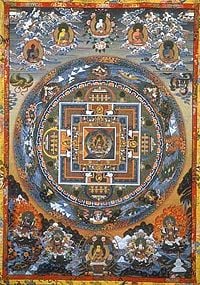
Buddhist art refers to the rich and diverse representations of religious images, sculpture, dance, visual mythology, and symbols deriving from the various Buddhist communities found around the world. Buddhist art exhibits distinctive forms and characteristics reflecting the diverse cultures and countries in which it has spread.
Early Buddhist art emerged in India and Sri Lanka following the death of Gautama Buddha (563 B.C.E. to 483 B.C.E.). This original, formative period of Buddhist art was aniconic in character (avoiding direct representation of the human figure). However, around the first century C.E., following the Greek invasion of northwestern India and Buddhist contact with Hellenistic culture in the Indo-Greek Kingdoms, an iconic period of Buddhist art began to flourish in India. The growth of Buddhist art, in turn, influenced the development of Hindu art, until Buddhism virtually disappeared in India around the tenth century due, in part, to the vigorous expansion of both Islam and Hinduism.
From its original homeland of India, Buddhist art was transported to other parts of Asia and the world, adapting to local styles and norms in each new host country. Today, Buddhist art constitues an important part of overall Buddhist cultural legacy.
History in India
Aniconic phase (fifth century - first century B.C.E.)
Although India has a long sculptural tradition and a mastery of rich iconography, the Buddha was not represented in human form during the first few centuries of Buddhism. This reluctance towards anthropomorphic representations of the Buddha, and the sophisticated development of aniconic symbols to avoid it (even in narrative scene where other human figures would appear), seems to be connected 70 Buddha’s sayings, reported in the Dighanikaya, that disfavored representations of himself after the extinction of his body. This tendency remained as late as the second century C.E. in the southern parts of India, in the art of the Amaravati school. While earlier anthropomorphic representations of the Buddha may have been made of wood and may have perished since then. However, no related archaeological evidence has been found.
What developed in the place of sculpted images of the Buddha was a rich period of aniconic art whereby the Buddha (and his teachings) were represented by diverse symbols. For example, some of these common symbols were the footprint (see picture inset), which represented, among other things, the Buddhist doctrine of anitya(impermanence), an empty throne, and the wheel of dhamma.
Iconic phase (1st century CE – present)
Anthropomorphic representations of the Buddha started to emerge from the first century C.E. in northern India. During the second to first century B.C.E., sculptures became more explicit, representing episodes of the Buddha’s life and teachings. These took the form of votive tablets or friezes, usually in relation to the decoration of stupas. The two main centers of creation have been identified as Gandhara in today’s Punjab, in Pakistan, and the region of Mathura, in central northern India.
The art of Gandhara benefited from centuries of interaction with Greek culture since the conquests of Alexander the Great in 332 B.C.E. and the subsequent establishment of the Greco-Bactrian and Indo-Greek Kingdoms, leading to the development of Greco-Buddhist art. Gandharan Buddhist sculpture displays Greek artistic influence, and it has been suggested that the concept of the “man-god” was essentially inspired by Greek mythological culture. Artistically, the Gandharan school of sculpture is said to have contributed wavy hair, drapery covering both shoulders, shoes and sandals, acanthus leaf decorations, etc.
The art of Mathura tends to be based on a strong Indian tradition, exemplified by the anthropomorphic representation of divinities such as the Yaksas, although in a style rather archaic compared to the later representations of the Buddha. The Mathuran school contributed clothes covering the left shoulder of thin muslin, the wheel on the palm, the lotus seat, etc.
Mathura and Gandhara also strongly influenced each other. During their artistic florescence, the two regions were even united politically under the Kushans, both being capitals of the empire. It is still a matter of debate whether the anthropomorphic representations of Buddha was essentially a result of a local evolution of Buddhist art at Mathura, or a consequence of Greek cultural influence in Gandhara through the Greco-Buddhist syncretism.
This iconic art was characterized from the start by a realistic idealism, combining realistic human features, proportions, attitudes and attributes, together with a sense of perfection and serenity reaching to the divine. This expression of the Buddha became the iconographic canon for subsequent Buddhist art.
The pink sandstone sculptures of Mathura evolved during the Gupta period (fourth to sixth century) to reach a very high fineness of execution and delicacy in their modeling. The art of the Gupta school was extremely influential almost everywhere in the rest of Asia. By the tenth century, Buddhist art creation was dying out in India, as Hinduism and Islam ultimately prevailed.
History Outside India
Northern Buddhist art
As Buddhism expanded outside of India from the first century C.E., its original artistic package blended with other artistic influences, leading to a progressive differentiation among the countries adopting the faith.
- A Northern route was established from the first century C.E. through Central Asia, Tibet, Bhutan, China, Korea, and Japan, in which Mahayana Buddhism prevailed.
- A Southern route, where Theravada Buddhism dominated, went through Myanmar, Thailand, Cambodia, and Vietnam.
The Silk Road transmission of Buddhism to Central Asia, China and ultimately Korea and Japan started in the first century C.E. with a semi-legendary account of an embassy sent to the West by the Chinese Emperor Ming (58-75 C.E.). However, extensive contacts started in the second century C.E., probably as a consequence of the expansion of the Kushan Empire into the Chinese territory of the Tarim Basin, with the missionary efforts of a great number of Central Asian Buddhist monks to Chinese lands. The first missionaries and translators of Buddhists scriptures into Chinese, such as Lokaksema, were either Parthian, Kushan, Sogdian or Kuchean.
Central Asian missionary efforts along the Silk Road were accompanied by a flux of artistic influences, visible in the development of Serindian art from the second through the 11th century CE in the Tarim Basin, modern Xinjiang. Serindian art often derives from the Greco-Buddhist art of the Gandhara district of what is now Pakistan, combining Indian, Greek and Roman influences. Silk Road Greco-Buddhist artistic influences can be found as far as Japan to this day, in architectural motifs, Buddhist imagery, and a select few representations of Japanese gods.
The art of the northern route was also highly influenced by the development of Mahayana Buddhism, an inclusive faith characterized by the adoption of new texts, in addition to the traditional Pali canon, and a shift in the understanding of Buddhism. Mahayana goes beyond the traditional Theravada ideal of the release from suffering (dukkha) and personal enlightenment of the arhats, to elevate the Buddha to a god-like status, and to create a pantheon of quasi-divine Bodhisattvas devoting themselves to personal excellence, ultimate knowledge and the salvation of humanity. Northern Buddhist art thus tends to be characterized by a very rich and syncretic Buddhist pantheon, with a multitude of images of the various Buddhas, Bodhisattvas and lesser deities.
Afghanistan
Buddhist art in Afghanistan (old Bactria) flourished for several centuries until the spread of Islam in the seventh century. It was exemplified by the Buddhas of Bamyan. Other sculptures, in stucco, schist or clay, display very strong blending of Indian post-Gupta mannerism and Classical influence, Hellenistic or possibly even Greco-Roman.
Although Islamic rule was rather tolerant of other religions “of the Book,” it showed little tolerance for Buddhism, which was perceived as a religion depending on idolatry. Human figurative art forms also being prohibited under Islam, Buddhist art suffered numerous attacks, which culminated with the systematic destructions by the Taliban regime. The Buddhas of Bamyan, the sculptures of Hadda, and many of the remaining artifacts at the Afghanistan museum have been destroyed.
The invasions and wars in Afghanistan since the 1980s also have led to a systematic pillage of archaeological sites apparently in the hope of reselling in the international market what artifacts could be found.
Central Asia
Central Asia long played the role of a meeting place between China, India and Persia. During the second century B.C.E., the expansion of the Former Han to the West led to increased contact with the Hellenistic civilizations of Asia, especially the Greco-Bactrian Kingdom.
Thereafter, the expansion of Buddhism to the North led to the formation of Buddhist communities and even Buddhist kingdoms in the oases of Central Asia. Some Silk Road cities consisted almost entirely of Buddhist stupas and monasteries, and it seems that one of their main objectives was to welcome and service travelers between East and West.
The eastern part of Central Asia (Chinese Turkestan (Tarim Basin, Xinjiang) in particular has revealed an extremely rich Serindian art (wall paintings and reliefs in numerous caves, portable paintings on canvas, sculpture, ritual objects), displaying multiple influences from Indian and Hellenistic cultures. Works of art reminiscent of the Gandharan style, as well as scriptures in the Gandhari script Kharoshti have been found. These influences were rapidly absorbed however by the vigorous Chinese culture, and a strongly Chinese particularism develops from that point.
China
Buddhism arrived in China around the 1st century CE, and introduced new types of art into China, particularly in the area of statuary. Receiving this distant religion, strong Chinese traits were incorporated into Buddhist art.
Northern Dynasties
In the 5th to 6th centuries, the Northern Dynasties, developed rather symbolic and abstract modes of representation, with schematic lines. Their style is also said to be solemn and majestic. The lack of corporeality of this art, and its distance from the original Buddhist objective of expressing the pure ideal of enlightenment in an accessible and realistic manner, progressively led to a change towards more naturalism and realism, leading to the expression of Tang Buddhist art.
Sites preserving Northern Wei Dynasty Buddhist sculpture include Longmen Grottoes, Henan, Bingling Temple, and Gansu.
Tang Dynasty
Following a transition under the Sui Dynasty, Buddhist sculpture of the Tang evolved towards a markedly life-like expression. Because of the dynasty’s openness to foreign influences, and renewed exchanges with Indian culture due to the numerous travels of Chinese Buddhist monks to India, Tang dynasty Buddhist sculpture assumed a rather classical form, inspired by the Indian art of the Gupta period. During that time, the Tang capital of Chang'an (today's Xi'an) became an important center for Buddhism. From there, Buddhism spread to Korea, and Japanese embassies of Kentoshi helped it gain a foothold in Japan.
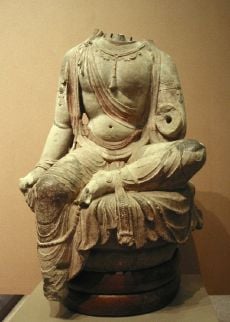
However, foreign influences came to be negatively perceived in China towards the end of the Tang dynasty. In the year 845, the Tang emperor Wuzong outlawed all “foreign” religions (including Christian Nestorianism, Zoroastrianism and Buddhism) in order to support the indigenous religion, Daoism. He confiscated Buddhist possessions, and forced the faith to go underground, therefore affecting the development of the religion and its arts in China.
Chán Buddhism (the origin of Japanese Zen), however, continued to prosper for some centuries, especially under the Song Dynasty (960-1279), when Chan monasteries were great centers of culture and learning.
The popularization of Buddhism in China has made the country home to one of the richest collections of Buddhist arts in the world. The Mogao Caves near Dunhuang and the Bingling Temple caves near Yongjing in Gansu province, the Longmen Grottoes near Luoyang in Henan province, the Yungang Grottoes near Datong in Shanxi province, and the Dazu Rock Carvings near Chongqing municipality are among the most important and renowned Buddhist sculptural sites. The Leshan Giant Buddha, carved out of a hillside in the eighth century during the Tang Dynasty and looking down on the confluence of three rivers, is still the largest stone Buddha statue in the world.
Korea
Korean Buddhist art generally reflects an interaction between Chinese Buddhist influence and a strongly original Korean culture. Additionally, the art of the steppes, particularly Siberian and Scythian influences, are evident in early Korean Buddhist art based on the excavation of artifacts and burial goods such as Silla royal crowns, belt buckles, daggers, and comma-shaped gogok.[1] The style of this indigenous art was geometric, abstract and richly adorned with a characteristic “barbarian” luxury. Although Chinese influence was strong, Korean Buddhist art "bespeaks a sobriety, taste for the right tone, a sense of abstraction but also of colours that curiously enough are in line with contemporary taste."[2]
Three Kingdoms of Korea
The first of the Three Kingdoms of Korea to officially receive Buddhism was Goguryeo in 372 C.E.[3] However, Chinese records and the use of Buddhist motifs in Goguryeo murals indicate the introduction of Buddhism earlier than the official date.[4] The Baekje Kingdom officially recognized Buddhism in 384 C.E..[5] The Silla Kingdom, isolated and with no easy sea or land access to China, officially adopted Buddhism in 535 C.E. although the foreign religion was known in the kingdom due to the work of Goguryeo monks since the early fifth century.[6] The introduction of Buddhism stimulated the need for artisans to create images for veneration, architects for temples, and the literate for the Buddhist sutras and transformed Korean civilization. Particularly important in the transmission of sophisticated art styles to the Korean kingdoms was the art of the "barbarian" Tuoba, a clan of non-Han Chinese Xianbei people who established the Northern Wei Dynasty in China in 386 C.E. The Northern Wei style was particularly influential in the art of the Goguryeo and Baekje. Baekje artisans later transmitted this style along with Southern Dynasty elements and distinct Korean elements to Japan. Korean artisans were highly selective of the styles they incorporated and combined different regional styles together to create a specific Korean Buddhist art style.[7][8]
While Goguryeo Buddhist art exhibited vitality and mobility akin with Northern Wei prototypes, the Baekje Kingdom was also in close contact with the Southern Dynasties of China and this close diplomatic contact is exemplified in the gentle and proportional sculpture of the Baekje, epitomized by Baekje sculpture exhibiting the fathomless smile known to art historians as the Baekje smile.[9] The Silla Kingdom also developed a distinctive Buddhist art tradition epitomized by the Bangasayusang, a half-seated contemplative maitreya whose Korean-made twin, the Miroku Bosatsu, was sent to Japan as a proselytizing gift and now resides in the Koryu-ji Temple in Japan.[10] Buddhism in the Three Kingdoms period stimulated massive temple-building projects, such as the Mireuksa Temple in the Baekje Kingdom and the Hwangnyongsa Temple in Silla. Baekje architects were famed for their skill and were instrumental in building the massive nine-story pagoda at Hwangnyongsa and early Buddhist temples in Yamato Japan such as Hoko-ji (Asuka-dera) and Hōryū-ji.[11] [12] Sixth century Korean Buddhist art exhibited the cultural influences of China and India but also showed distinctive indigenous characteristics.[13] [14] Particularly, the semi-seated Maitreya form was adapted into a highly developed Korean style, which was transmitted to Japan as evidenced by the Koryu-ji Miroku Bosatsu and the Chugu-ji Siddhartha statues. Although many historians portray Korea as a mere transmitter of Buddhism, the Three Kingdoms, and particularly Baekje, were instrumental as active agents in the introduction and formation of a Buddhist tradition in Japan in 538 or 552.[15] These Korean characteristics can be seen in early Buddhist art in Japan and some early Japanese Buddhist sculpture is now believed to have originated in Korea, particularly from Baekje, or Korean artisans who immigrated to Yamato Japan.
Unified Silla
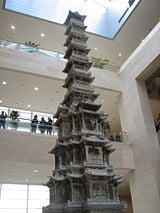
During the Unified Silla period, East Asia was particularly stable with China and Korea both enjoying unified governments. Early Unified Silla art combined Silla styles and Baekje styles. Korean Buddhist art was also influenced by new Tang Dynasty styles as evidenced by a new popular Buddhist motif with full-faced Buddha sculptures. Tang China was the cross roads of East, Central, and South Asia and so the Buddhist art of this time period exhibited the so-called international style. State-sponsored Buddhist art flourished during this period, the epitome of which was the Seokguram Grotto.
Goryeo Dynasty
The fall of the Unified Silla Dynasty and the establishment of the Goryeo Dynasty in 918 C.E. indicates a new period of Korean Buddhist art. The Goryeo kings also lavishly sponsored Buddhism and Buddhist art flourished, especially Buddhist paintings and illuminated sutras written in gold and silver ink. [3]. The crowning achievement of this period is the carving of approximately 80,000 woodblocks of the Tripitaka Koreana, which was done twice.
Joseon Dynasty
The Joseon Dynasty actively suppressed Buddhism beginning in 1406 C.E. and Buddhist temples and art production subsequently declined in quality and quantity.[16]
Japan
Before the introduction of Buddhism into Japan, the land of Japan had already been the seat of various cultural (and artistic) influences, from the abstract linear decorative art of the indigenous Neolithic Jōmon (from around 10,500 B.C.E. to 300 B.C.E.), to the art during the Yayoi and Kofun periods, with developments such as Haniwa art.
Japan discovered Buddhism in the sixth century when monks traveled to the islands bringing numerous scriptures and works of art. The Buddhist religion was adopted by the state in the following century. Being geographically at the end of the Silk Road, Japan was able to preserve many aspects of Buddhism at the very time it was disappearing in India, and being suppressed in Central Asia and China.

From 710 C.E., numerous temples and monasteries were built in the capital city of Nara, including a five-story pagoda, the Golden Hall of the Horyuji, and the Kōfuku-ji temple. Countless paintings and sculptures were made, often under governmental sponsorship. Indian, Hellenistic, Chinese and Korean artistic influences blended into an original style characterized by realism and gracefulness. The creation of Japanese Buddhist art was especially rich between the 8th and 13th centuries during the periods of Nara, Heian and Kamakura. Japan developed an extremely rich figurative art for the pantheon of Buddhist deities, sometimes combined with Hindu and Shinto influences. This art can be very varied, creative and bold.
From the twelfth and thirteenth centuries, a further development in Japanese art was Zen art, following the introduction of the faith by Dogen and Eisai upon their return from China. Zen art is mainly characterized by original paintings (such as sumi-e) and poetry (especially haikus), striving to express the true essence of the world through impressionistic and unadorned “non-dualistic” representations. The search for enlightenment “in the moment” also led to the development of other important derivative arts such as the Chanoyu tea ceremony or the Ikebana art of flower arrangement. This evolution went as far as considering almost any human activity as an art with a strong spiritual and aesthetic content, first and foremost in those activities related to combat techniques (martial arts) (See Bushido).
Buddhism remains very active in Japan to this day. Still around 80,000 Buddhist temples are preserved. Many of them are in wood and are regularly restored.
Tibet and Bhutan
Tantric Buddhism started as a movement in eastern India around the 5th or the 6th century. Many of the practices of Tantric Buddhism are derived from Brahmanism (the usage of mantras, yoga, or the burning of sacrificial offerings). Other practices come from heterodox traditions. Indian tantric Buddhism was imported into Tibet where it also absorbed ritual practices from the indigenous Bon traditions. Tantrism became the dominant form of Buddhism in Tibet from the eighth century. Due to its geographical centrality in Asia, Tibetan Buddhist art received influence from Indian, Nepali, Greco-Buddhist and Chinese art.
One of the most characteristic creations of Tibetan Buddhist art are its use of mandalas, diagrams of a “divine temple” made of a circle enclosing a square, the purpose of which is to help Buddhist worshipers focus their attention through meditation and follow the path to the central image of the Buddha. Artistically, Buddhist Gupta art and Hindu art tend to be the two strongest inspirations of Tibetan art.
Vietnam
Chinese influence was predominant in the northern Vietnam (Tonkin) was influenced by Xhinese Confucianism and Mahayana Buddhism between the first and ninth centuries C.E. Consequently, the art of Vietnam has strong connections to Chinese Buddhist art.
In the south, the kingdom of Champa has a strongly Indianized art, just as neighboring Cambodia. Many of its statues were characterized by rich body adornments. The capital of the kingdom of Champa was annexed by Vietnam in 1471 C.E., and it totally collapsed in the 1720s.
Southern Buddhist art
During the first century C.E., the trade on the overland Silk Road tended to be restricted by the rise of the Parthian empire in the Middle East, an unvanquished enemy of Rome, just as Romans were becoming extremely wealthy and their demand for Asian luxury was rising. This demand revived the sea connections between the Mediterranean Sea and China, with India as the intermediary of choice. From that time, through trade connections, commercial settlements, and even political interventions, India started to strongly influence Southeast Asian countries. Trade routes linked India with southern Burma, central and southern Siam, lower Cambodia and southern Vietnam, and numerous urbanized coastal settlements were established there.
For more than a thousand years, Indian influence was therefore the major factor that brought a certain level of cultural unity to the various countries of the region. The Pali and Sanskrit languages and the Indian script, together with Mahayana and Theravada Buddhism, Brahmanism and Hinduism, were transmitted from direct contact and through sacred texts (such as the Ramayana and the Mahabharata). This expansion provided the artistic context for the development of Buddhist art in these countries.
Between the first and eighth centuries, several kingdoms competed for influence in the region (particularly the Cambodian Funan then the Burmese Mon kingdoms) contributing various artistic characteristics, mainly derived from the Indian Gupta style. Combined with a pervading Hindu influence, Buddhist images, votive tablets and Sanskrit inscriptions are found throughout the area.
From the ninth to the thirteenth centuries, Southeast Asia had very powerful empires and became extremely active in Buddhist architectural and artistic creation. The Sri Vijaya Empire to the south and the Khmer Empire to the north competed for influence, but both were adherents of Mahayana Buddhism, and their art expressed the rich Mahayana pantheon of the Bodhisattvas. The Theravada Buddhism of the Pali canon was introduced to the region around the thirteenth century from Sri Lanka, and was adopted by the newly founded ethnic Thai kingdom of Sukhothai. Since in Theravada Buddhism only monks can reach Nirvana, the construction of temple complexes plays a particularly important role in the artistic expression of Southeast Asia from that time.
From the fourteenth century, the main factor was the spread of Islam to the maritime areas of Southeast Asia, overrunning Malaysia, Indonesia, and most of the islands as far as the Philippines. In the continental areas, Theravada Buddhism continued to expand into Burma, Laos and Cambodia.
Myanmar
As a neighbor of India, Myanmar (formerly known as Burma) was strongly influenced by Indian art. The Mon of southern Burma are said to have been converted to Buddhism around 200 B.C.E. under the proselytizing of the Indian king Ashoka, before the schism between Mahayana and Hinayana Buddhism.
Early Buddhist temples are found in the area, such as Beikthano in central Myanmar, with dates between the 1st and the 5th centuries. The Buddhist art of the Mons was especially influenced by the Indian art of the Gupta and post-Gupta periods, and their mannerist style spread widely in Southeast Asia following the expansion of the Mon Empire between the fifth and eighth centuries.
Later, thousands of Buddhist temples were built at Pagan, the capital, between the eleventh and thirteenth centuries, and around 2,000 of them are still standing. Beautiful jeweled statues of the Buddha are remaining from that period. Artistic development managed to continue despite the seizure of the city by the Mongols in 1287 C.E.
Cambodia
Cambodia was the center of the Funan kingdom, which expanded into Burma as far south as Malaysia between the third and sixth centuries C.E.
From the ninth to thirteenth centuries, the Mahayana Buddhist and Hindu Khmer Empire dominated vast parts of the Southeast Asian peninsula, and its influence was foremost in the development of Buddhist art in the region. Under the Khmer, more than 900 temples were built in Cambodia and in neighboring Thailand.
Angkor was at the center of this development, with a Buddhist temple complex and urban organization able to support around 1 million urban dwellers. A great deal of Cambodian Buddhist sculpture is preserved at Angkor; however, organized looting has had a heavy impact on many sites around the country.
Often, Khmer art manages to express intense spirituality through divinely beaming expressions, in spite of spare features and slender lines.
Thailand
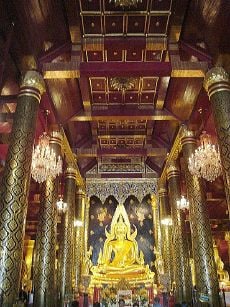
From the first to the seventh centuries, Buddhist art in Thailand was first influenced by direct contact with Indian traders and the expansion of the Mon kingdom, leading to the creation of Hindu and Buddhist art inspired from the Gupta tradition, with numerous monumental statues of great virtuosity.
From the ninth century, the various schools of Thai art then became strongly influenced by Cambodian Khmer art in the north and Sri Vijaya art in the south, both based on the Mahayana faith. Up to the end of that period, Buddhist art is characterized by a clear fluidness in its expression, and the subject matter is characteristic of the Mahayana pantheon, with multiple creations of Bodhisattvas.
From the thirteenth century, Theravada Buddhism was introduced from Sri Lanka around the same time as the ethnic Thai kingdom of Sukhothai was established. The new faith inspired highly stylized images, with sometimes very geometrical and almost abstract figures.
During the Ayutthaya period (fourteenth-eighteenth centuries), the Buddha came to be represented in a more stylistic manner with sumptuous garments and jeweled ornamentations. Many Thai sculptures or temples tended to be gilded, and on occasion enriched with inlays.
Indonesia
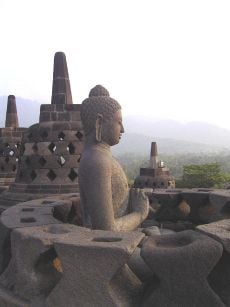
Like the rest of Southeast Asia, Indonesia seems to have been most strongly influenced by India from the first century C.E. The islands of Sumatra and Java in western Indonesia were the seat of the empire of Sri Vijaya (eighth-thirteenth century C.E.), which came to dominate most of the area around the Southeast Asian peninsula through maritime power. The Sri Vijayan Empire had adopted Mahayana and Vajrayana Buddhism, under a line of rulers named the Sailendras. Sri Vijaya spread Mahayana Buddhist art during its expansion into the Southeast Asian peninsula. Numerous statues of Mahayana Bodhisattvas from this period are characterized by a very strong refinement and technical sophistication, and are found throughout the region.
Extremely rich and refined architectural remains are can be found in Java and Sumatra. The most magnificence is the temple of Borobudur (the largest Buddhist structure in the world, built from around 780-850 C.E.). This temple was modeled after Buddhist concept of universe, the Mandala which counts 505 images of the seated Buddha and unique bell-shaped stupa that contains the statue of Buddha. Borobudur is adorned with long series of bas-reliefs narrating the holy Buddhist scriptures. The Mendut temple near Borobudur, houses the giant statue of Buddha, Avalokitesvara, and Vajrapani.
The oldest Buddhist structure in Indonesia probably is the Batu Jaya stupas at Karawang, West Java, dated from around fourth century C.E. This temple is some plastered brick stupas. However, Buddhist art in Indonesia reach the golden era during the Sailendra dynasty rule in Java. The bas-reliefs and statues of Bodhisattva, Tara, and Kinnara found in Kalasan, Sewu, Sari, and Plaosan temple are very graceful with serene expressions.
In Sumatra, the Sri Vijaya Empire also built the temple of Muara Takus, and Muaro Jambi. The most beautiful classical Javanese art is the serene and delicate statue of Prajnaparamita (the collection of National Museum Jakarta) the goddess of transcendental wisdom from Singhasari. The Indonesian Buddhist Empire of Sri Vijaya declined due to conflicts with the Chola rulers of India, then followed by Majapahit empire, before being destabilized by the Islamic expansion from the thirteenth century.
Notes
- ↑ James Huntley Grayson. Korea: A Religious History. (UK: Routledge, 2002), 21.
- ↑ Pierre Cambon, Arts asiatiques- Guimet'
- ↑ Grayson (2002), 25.
- ↑ Grayson (2002), 24.
- ↑ Grayson (2002), 25.
- ↑ Peter N. Stearns and William Leonard Langer. The Encyclopedia of World History: ancient, medieval, and modern, chronologically arranged. (Houghton Mifflin, 2001. ISBN 0395652375)
- ↑ Grayson (2002), 27 & 33.
- ↑ Korean Buddhist Sculpture, 5th–9th Century Timeline of Arts History. The Metropolitan Museum of Art accessdate 2007-01-09
- ↑ metmuseum.org
- ↑ Holland Cotter, "Japanese Art and Its Korean Secret." in: The New York Times online April 6, 2003, kenyon.edu.Retrieved March 29, 2008.
- ↑ Sir Banister Fletcher's A History of Architecture, 20th ed. "Japan and Korea" [1]; orientalarchitecture.com Oriental Architecture.com.Retrieved March 29, 2008.
- ↑ Shin Young-hoon, "History of Korea: Architecture" indiana.edu. Retrieved March 29, 2008.
- ↑ Timeline of Art History: "Korea, 500–1000 C.E." metmuseum.org.Retrieved March 29, 2008.
- ↑ Donald F. McCallum, "Korean Influence on Early Japanese Buddhist Sculpture." buddhapia.com.Retrieved March 29, 2008.
- ↑ Grayson, (2002), 33.
- ↑ Jay A. Levenson. Circa 1492: Art in the Age of Exploration. online [2].Retrieved March 29, 2008.
ReferencesISBN links support NWE through referral fees
- Foltz, Richard. Religions of the Silk Road. New York: St. Martin’s Griffin, 1999. ISBN 0312233388
- Grayson, James Huntley. Korea: A Religious History. London, UK: Routledge, 2002. ISBN 070071605X
- Huntington, Susan L. "Early Buddhist art and the theory of aniconism." Art Journal (Winter 1990).
- Jarrige, Jean-François. Arts asiatiques- Guimet. Paris: Éditions de la Réunion des Musées Nationaux, 2001. ISBN 2711838978
- Lee, Sherman. A History of Far Eastern Art, 5th Edition. New York: Prentice Hall, 2003. ISBN 0131833669
- Levenson, Jay A. Circa 1492: Art in the Age of Exploration.
- McCallum, Donald F. "Korean Influence on Early Japanese Buddhist Sculpture." buddhapia.com
- Scarre, Dr. Chris (ed.) Past Worlds. The Times Atlas of Archeology. London: Times Books Limited, 1991. ISBN 0723003068
- Stearns, Peter N., and William Leonard Langer. The Encyclopedia of World History: ancient, medieval, and modern, chronologically arranged. Houghton Mifflin, 2001. ISBN 0395652375
External links
All links retrieved November 22, 2023.
Credits
New World Encyclopedia writers and editors rewrote and completed the Wikipedia article in accordance with New World Encyclopedia standards. This article abides by terms of the Creative Commons CC-by-sa 3.0 License (CC-by-sa), which may be used and disseminated with proper attribution. Credit is due under the terms of this license that can reference both the New World Encyclopedia contributors and the selfless volunteer contributors of the Wikimedia Foundation. To cite this article click here for a list of acceptable citing formats.The history of earlier contributions by wikipedians is accessible to researchers here:
The history of this article since it was imported to New World Encyclopedia:
Note: Some restrictions may apply to use of individual images which are separately licensed.
